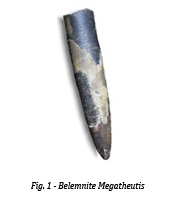Belemnites
O Cabo Mondego é um verdadeiro livro da História Geológica do
período Jurássico, entre os 185 e os 120 M. A. (milhões de anos). A
Rota do Jurássico é um conjunto de earthcaches que lhe vão dar
oportunidade de “viver” nos tempos em que os
Megalossáurios calcorreavam este litoral. Ao longo de cerca de 2 km
de arriba, poderá ver sucederem-se diversos paleoambientes,
resultado de regressões e transgressões marinhas ocorridas nesta
zona, apreciar as formações e as estruturas de origem sedimentar,
observar muitos registos fósseis, animais e vegetais,
impressionar-se com as forças tectónicas que ergueram e inclinaram
as bancadas calcárias, enfim, arrebatar-se com a presença de um
verdadeiro tesouro super-antiquíssimo. Um tesouro único, que temos
à nossa disposição e que é de todos nós. Tome atenção especial à
sua preservação – se quiser levar alguma recordação para casa
(rochas, fósseis, etc.) leve-a na máquina fotográfica/GPS ou
telemóvel.
E se trouxer algum saco de plástico faça um CITO (cache in trash
out)!

O grupo dos coleóides inclui
lulas, chocos, polvos e vários subgrupos extintos de onde se
destacam as belemnites. Destes, apenas as belemnites são geralmente
conservados como fósseis.

Este grupo é caracterizado
por possuir uma concha interna totalmente fechada por tecidos
musculares moles. A concha divide-se em três partes:
- o fragmocone -
que é a concha propriamente dita - dividido em câmaras;
- o proostraco -
prolongamento dorsal do fragmocone;
- o rostro -
rodeia o fragmocone.
Geralmente é apenas o rostro
que fossiliza, uma vez que é formado por camadas de
calcite.
As belemnites apareceram na
era Paleozóica (mais de 200 milhões de anos), tendo tido o seu
apogeu nos mares Mesozóicos. São abundantes em níveis do Jurássico,
como acontece no Cabo Mondego.
Extinguiram-se no final do
Cretácico (há 65 milhões de anos) ao mesmo tempo que as
amonites, os
dinossauros e outros grupos.
Animais coleóides -
pertencem a Subclasse Coleoidea, Classe Cephalopoda, Filo
Mollusca
http://fossil.uc.pt/pags/fbm_coleoides.dwt#
http://e-geo.ineti.pt/MuseuGeologico/museu/salas/paleontologia/belemnites.htm

As belemnites eram animais
carnívoros nectónicos (nadam livremente nos oceanos) e muito
semelhantes às lulas actuais. Eram eficientes predadoras de peixes
e outros animais marinhos de pequeno porte usando os seus
tentáculos para agarrar as presas. Os tentáculos das belemnites
tinham ganchos em vez de ventosas.
Podiam mover-se rapidamente,
usando propulsão a jacto e provavelmente esperavam entre as algas e
pedras, as suas presas que atacavam rapidamente.
Adaptado e
traduzido de
http://www.abc.net.au/science/ozfossil/ageofreptiles/eromanga/belemnites.htm
No cabo Mondego podem
encontrar-se belemnites em vários locais, como o afloramento das
coordenadas. Suba o afloramento e observe várias belemnites como as
que se mostram na fig. 4.
Atenção:
Observe
o afloramento com atenção. Para logar terá que me enviar por
mail:
a)
uma pequena descrição do afloramento que o caracterize
em termos de erosão.
b)
qual a espessura aproximada do estrato mais largo, no cimo do
afloramento.
Belemnites
The Cabo Mondego is a true book of
Geological History of the Jurassic period, between 185 and 120 M.
A. (million years). “Route of Jurassic” is a set of
earth caches that will give you the opportunity to "live" in the
days when the Megalosaurs walked over this coast. Over about 2 km
of cliff you can see different paleoenvironments result of marine
transgressions and regressions occurred in this area, examine the
sediment formations, observe many records fossils, impress
themselves with the limestone strata that were tilted by tectonic
forces and finally to feel a super-ancient real treasure. This is
an unique treasure that we have at our disposal and that belongs to
all of us. Take special care to preserve the environment - if you
want to take home some souvenir (rocks, fossils, etc.). Take it in
your camera / GPS or mobile phone.
And if you bring a plastic bag, make
a CITO (cache in trash out)!
The coloidea
group includes squid, cuttlefish,
octopus and several extinct subgroups where we highlight belemnites. From these subgroups, only belemnites became
fossils.
This group is characterized to have an intern shell
totally closed by soft muscular tissues. The shell is divided into
three parts:
- the phragmocone – the shell itself – it is
divided into cameras; (fig.2)
- the proostracum – dorsal extension of the
phragmocone; (fig.2)
- the rostrum- it surrounds the phragmocone.
(fig.2)
Generally only the rostrum fossilizes because it is formed
by layers of calcite.
The belemnites appeared in Paleozóic era (over 200 million
years) and reached its peak in the Mesozóic oceans. They are
abundant in Jurassic stratus, like it happens in Cabo Mondego. They
became extinct in final of Cretacic (65 million years ago) with the
amonits, dinossaurs and other groups.
Coloidea animals - belong to Subclass Coloidea, Class
Cephalopoda, Phyllum Mollusca
Belemnites were nektonic (they swim in open sea waters)
carnivores animals very
similar to the current squid. They were excellent predators of fish and other small
marine animals using tentacels to catch their prey. The belemnites
tentacels had hooks instead of suckers.
They moved quickly with a system of jact propulsion
and probably they wait the preys among algae and rocks to strike
quickly.
In Cabo Mondego we can find the belemnites in several
places, like in the outcrop of the coordinates. Climb the outcrop
and observe several belemnites like those shown in
fig.4.
ATTENTION: Observe carefully the outcrop.
Before you log your found you must e-mail
me:
a) a short description of the outcrop
with their characteristics in terms of
erosion.
b) what’s the average thickness
of the largest strata on the outcrop’s top